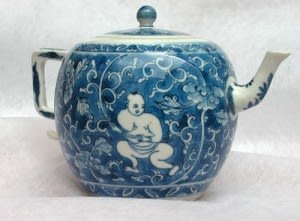Of oval form, with curved spout, c-shaped handle and flat cover, the body finely painted with a well delineated continuous scene of two little boys, scantily dressed, both adorned with anklets and bracelets amidst peony scrolls reserved in white on shaded blue ground, the curved spout with two sprays of prunus, the handle with stylised flower-heads, the cover similarly decorated with sprays of peony reserved on a blue ground, the base glazed with an underglaze double blue ring and artemisia leaf.
Literature
For a similar example see Oriental Porcelain, A Choice from the Boymans-van Beuningen Museum Collection, C.J.A. Jorg, Museum Boymans-van Beuningen, Rotterdam, 1995, pl 12, p 35, which he dates to ca 1700, this was a gift by Van Rijckevorsel in 1910 to the Rijksmuseum, Jorg discusses this teapot and here we quote; ?This teapot was made in Jingdezhen, the centre for porcelain production in the province of Jianxi. However, in terms of both shape and decoration, it is a direct imitation of a teapot produced in Yixing, in the province of Jiangsu. Here, the potters specialized in teapots made of red, unglazed stoneware, some of which were also exported. One type of Yixing teapot often found in Western collections has the same motif of a little boy amidst flower scrolls, executed in low relief. Presumably this type was made especially for export; its success then inspired porcelain imitations. Even the decorative bands around the upper rim and the foot have been carefully copied from the Yixing original. A Yixing teapot of this type, with an angular handle similar to the one on this Jingdezhen piece, is kept in Duivenvoorde Castle at Voorschoten, and another in Amsterdam?s Rijksmuseum.? References; Beurdeley & Raindre 1986, fig 357, Lo 1986, pl. XXXVI Kallenborn 1993.

